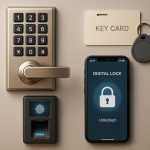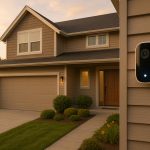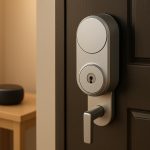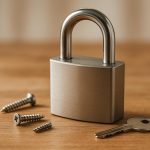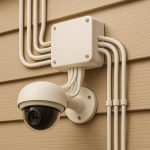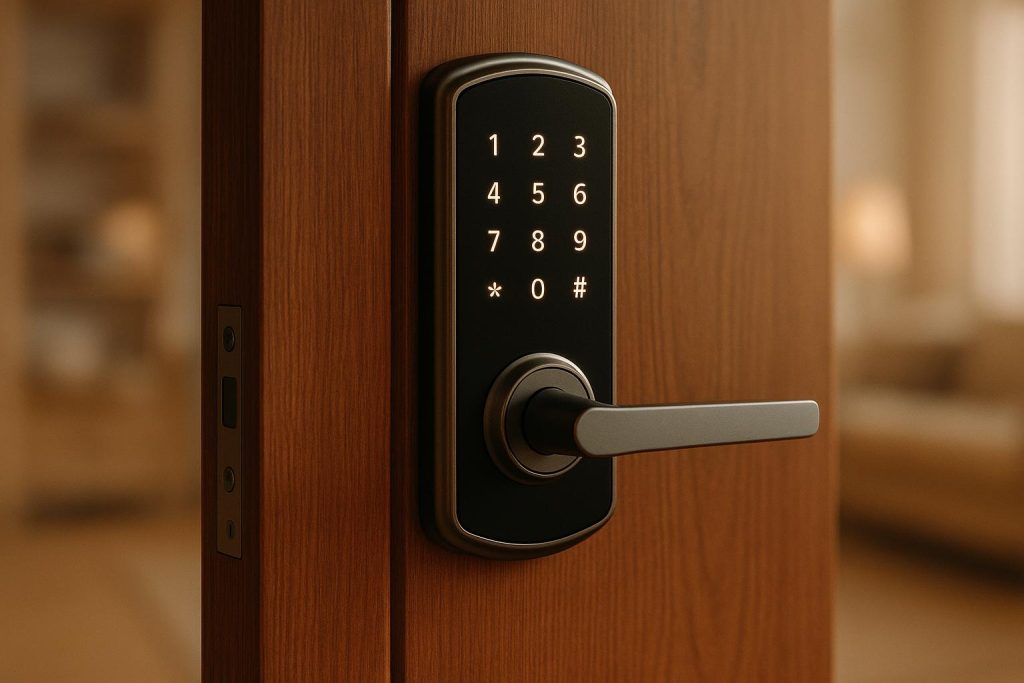Keyless entry locks offer convenience and advanced security features but come with unique challenges. They eliminate the need for physical keys, use technologies like PIN codes, biometrics, or smartphone apps, and often integrate with smart home systems. However, they also introduce risks like hacking, power outages, and system malfunctions.
Key Takeaways:
- Advantages: No lost keys, remote access, temporary access codes, and detailed access logs.
- Challenges: Dependence on batteries or power, higher costs, and vulnerability to cyber threats.
- Security Features: Encryption, rolling codes, biometric authentication, and firmware updates.
- Best Practices: Use strong access codes, enable multi-factor authentication, and ensure professional installation.
While keyless locks improve security in many ways, proper maintenance, regular updates, and professional setup are essential to maximize their reliability and safety.
Are Smart Locks Safe? A Lock Expert Explains | WSJ
Security Risks of Keyless Entry Locks
Keyless entry systems rely heavily on electricity and technology, which can leave them exposed to potential outages and system malfunctions. Let’s take a closer look at how power and technical issues can impact these systems. These vulnerabilities are in addition to other risks like hacking and the use of weak access codes, which will be explored later.
Power and Technical Failures
Unlike mechanical keypad locks that function with simple gears and push buttons, electronic keyless systems require either batteries or a wired power source to operate. Battery-powered systems can usually maintain functionality during a power outage, but wired systems are at risk of completely shutting down when the power goes out.
Security Features of Modern Keyless Entry Systems
Modern keyless entry systems are designed with a range of advanced features to address potential vulnerabilities and provide a higher level of security than traditional locks. These systems tackle issues like power outages, hacking threats, and weak access codes by layering multiple defenses to prevent unauthorized access.
Encryption and Rolling Codes
To safeguard communication between key fobs, smartphones, and locks, most modern systems use AES (Advanced Encryption Standard) with either 128-bit or 256-bit encryption. This is the same level of encryption trusted by banks and government agencies, ensuring a highly secure connection.
In addition, rolling code technology adds another layer of protection by generating a new, unique code for every unlock attempt. Instead of reusing the same signal, the system updates both the remote device and the lock’s internal counters with each interaction. This prevents replay attacks, as intercepted codes are rendered useless after a single use.
Biometric and Multi-Factor Authentication
Fingerprint scanners are becoming a popular feature in keyless entry systems for homes and businesses. These biometric readers can store multiple fingerprints and offer a level of accuracy that makes duplication nearly impossible. Unlike PIN codes or passwords, fingerprints can’t be easily shared or observed, making them a more secure option.
Many systems now combine biometrics with additional authentication methods, such as passcodes or smartphone verification. This multi-factor approach ensures that even if one layer of security is compromised, unauthorized access remains unlikely.
Firmware Updates and Maintenance
To stay ahead of emerging threats, manufacturers provide regular firmware updates for keyless entry systems. These updates patch vulnerabilities and improve overall security. Many systems now offer automatic updates, which install these patches without requiring user action, ensuring even non-technical users stay protected.
Some high-end systems also include remote monitoring capabilities. Security technicians can use these features to detect unusual activity, such as repeated failed access attempts or system malfunctions, and notify users or service providers of potential issues.
Battery monitoring is another critical feature, with systems providing alerts when power levels run low. Notifications are often sent via smartphone or email, helping users avoid lockouts caused by dead batteries. Together, these proactive measures ensure that keyless entry systems remain reliable and secure over time.
Best Practices to Improve Keyless Entry Lock Security
Keyless entry systems provide solid security, but a few proactive measures can make them even more effective.
Update Access Codes and Firmware Regularly
Changing access codes regularly is a simple way to close potential security gaps. Choose codes that are hard to guess – steer clear of patterns or obvious sequences.
For households or businesses with multiple users, take advantage of temporary codes for service providers or guests. These temporary codes can be set to expire automatically after a specific time, removing the need to manually deactivate them. Many modern systems allow you to create multiple unique codes, each with its own permissions and time limits.
Don’t forget to keep your system’s firmware up to date. Firmware updates often address security vulnerabilities and improve overall performance. While some systems update automatically, older models may require manual updates.
Enable Multi-Factor Authentication
Adding an extra layer of authentication significantly boosts your system’s security. For example, activating fingerprint scanning alongside a PIN ensures that even if someone sees you enter your code, they still can’t gain access without your physical presence.
Smartphone-based authentication is another powerful tool. Many keyless entry systems now sync with mobile apps that use features like Face ID or Touch ID to confirm your identity. Some systems even require both a PIN and smartphone verification within a specific time frame, making unauthorized access nearly impossible.
In high-security settings, consider combining multi-factor authentication with time-based restrictions. For instance, you can program the system to require additional verification during certain hours or limit access to specific days. This approach is especially useful for businesses or properties that are more vulnerable during off-peak times.
Choose Professional Installation
Even with advanced features, a poorly installed keyless entry lock can compromise your security. A professional installation ensures the lock is properly aligned with your door frame, reducing gaps or misalignment that could make it easier to tamper with. Misaligned locks can also wear down over time, leading to mechanical failures.
Professional installers also assess whether your door and frame can handle the weight and electronic components of a smart lock. Since these locks are generally heavier than standard deadbolts, reinforced door frames are often necessary to prevent sagging or other issues.
Certified technicians ensure reliable power connections and test critical features like backup power and emergency overrides. Some manufacturers even require professional installation to keep your warranty valid. Improper installation could void those protections, leaving you unprotected if something goes wrong.
For residents in Pittsburgh, PA, services like Sherlock’s Locksmith offer expert installation and maintenance to ensure your keyless entry system performs flawlessly and securely.
sbb-itb-643e28e
Pros and Cons of Keyless Entry Locks
Keyless entry locks bring a mix of advantages and challenges that both homeowners and businesses should weigh carefully. By understanding the benefits and potential drawbacks, you can decide if these systems fit your security needs and daily routine.
The standout benefit is convenience. With keyless locks, you no longer have to worry about losing your keys or hiding spare ones. These systems also make it easy to grant temporary access to others without needing to duplicate physical keys.
Another major perk is remote access. Many modern systems allow you to lock or unlock doors using your smartphone, no matter where you are. Whether you’re at work or traveling, you can let someone in or check on your property with just a few taps. This feature offers a level of control and oversight that traditional locks simply can’t match.
On the downside, keyless locks rely on electronic components, which introduces potential issues not present in traditional locks. Battery failures, for instance, can cause delays, though most systems provide low-battery warnings well in advance. Additionally, cost is a consideration. Keyless locks can cost 3 to 8 times more upfront than traditional locks, and you might also face professional installation and ongoing maintenance expenses.
While keypad systems are user-friendly, smartphone integrations and advanced features can pose a challenge for those less comfortable with technology. Extreme weather conditions may also impact battery life and touchscreen functionality.
Comparison Table: Pros and Cons
| Advantages | Disadvantages |
|---|---|
| No lost keys – Avoids lockouts due to misplaced keys | Battery dependency – Batteries can die, causing temporary lockouts |
| Remote access – Control locks from anywhere via smartphone | Higher upfront cost – More expensive than traditional locks |
| Temporary access codes – Easy guest access without physical keys | Learning curve – Advanced features may confuse non-tech-savvy users |
| Access logging – Tracks who enters and when | Hacking risks – Vulnerable to cyber threats |
| No rekeying needed – Change codes instead of replacing locks | Power outages – Some systems may fail during electrical disruptions |
| Multiple user codes – Individual codes for family or staff | Weather impact – Extreme conditions may affect performance |
| Smart home integration – Works with other security devices | Ongoing maintenance – Regular updates and battery replacements required |
One area where keyless systems shine is in security monitoring. They eliminate risks tied to lost keys, lock picking, and unauthorized key duplication. However, they also introduce new concerns like cybersecurity threats and the risk of someone observing you enter your PIN.
Maintenance needs are another key difference. While traditional locks can last for decades with minimal upkeep, keyless systems require regular attention, such as battery changes, firmware updates, and occasional troubleshooting. This ongoing upkeep can add both time and cost.
For businesses, the ability to generate audit trails is a significant advantage. Keyless systems can log every entry attempt – successful or not – providing detailed records for security analysis. This feature is particularly useful for commercial and rental properties, where managing access is crucial for liability and security.
Ultimately, the mix of benefits and challenges highlights the importance of professional installation and regular maintenance to get the most out of your keyless entry system.
Professional Keyless Entry System Services
Get the most out of your keyless entry system with expert installation and maintenance. Professional services not only integrate seamlessly with modern security systems but also enhance their overall performance and reliability.
When you choose professional installation, you’re setting the foundation for a system that works efficiently from day one. Skilled locksmiths bring specialized knowledge of smart locks, biometric scanners, and commercial access control systems. This expertise ensures you get the right system for your needs, installed and configured correctly.
Proper installation matters. Expert locksmiths ensure precise alignment, secure mounting, and correct electrical connections. These steps help prevent common issues like battery drain, connectivity failures, or premature wear and tear, ultimately extending the life of your system.
Take Sherlock’s Locksmith in Pittsburgh, PA, for example. They offer certified installation and maintenance services for residential smart locks and commercial access control systems. With their 24/7 mobile service, you can count on them for help anytime – whether it’s a power outage or a technical glitch disrupting your system.
Routine maintenance is another key advantage of professional services. Regular firmware updates and system checks can catch potential problems before they escalate into major issues like lockouts or costly repairs. This proactive approach ensures your system continues to operate smoothly.
If something does go wrong, professional locksmiths provide emergency support to quickly restore access. Unlike traditional lockout fixes, these experts can resolve smart lock malfunctions without compromising your system’s integrity.
For businesses, professional services offer added benefits like multi-code management, integration with broader security systems, and help with meeting compliance standards – features that traditional lock solutions simply can’t match.
Investing in professional services also reduces downtime and helps your system last longer. With proper care, your keyless entry system will deliver consistent performance while keeping its warranty intact – something unauthorized modifications could jeopardize.
For homeowners and businesses alike, working with a local professional locksmith brings peace of mind. Their technical expertise, 24/7 availability, and ongoing support ensure your keyless entry system provides the convenience and security you need.
Conclusion
Keyless entry locks bring a blend of convenience and enhanced security, but like any technology, they come with their own set of challenges.
Modern systems rely on encryption, rolling codes, and biometrics to protect access. However, potential risks like hacking, weak access codes, and power outages still require attention. Beyond the technology itself, the key to maintaining security lies in proper installation, configuration, and regular maintenance. Keeping software updated and using strong, unique access codes can significantly improve your system’s reliability.
When it comes to ensuring your system’s effectiveness, professional installation and ongoing support are game-changers. Certified technicians not only handle the setup but also fine-tune security features and proactively address potential issues. Their expertise ensures that your system performs at its best for years to come.
For homeowners and businesses exploring keyless entry solutions, these systems offer real benefits when implemented with care. The combination of convenience and advanced security makes them an excellent choice for modern access control.
Looking to upgrade or install a keyless entry system? Sherlock’s Locksmith in Pittsburgh provides certified installation and 24/7 support, ensuring your system delivers both ease of use and dependable security. Smart decisions today can shape a safer tomorrow.
FAQs
Are keyless entry locks safe from hacking and other security risks?
Keyless entry locks offer a convenient way to secure your home, but their effectiveness depends on proper use and maintenance. Start by selecting a reputable brand that provides regular firmware updates to patch any vulnerabilities. It’s also essential to create strong, unique PINs or passwords – steer clear of obvious choices like birthdays or simple sequences.
To further safeguard your system, think about using signal-blocking pouches for key fobs to thwart relay attacks. Adding security cameras near entry points can serve as an extra layer of protection against unauthorized access. Make it a habit to check for updates or new features for your lock to stay ahead of emerging threats. With these precautions, you can enjoy the ease of keyless entry without sacrificing security.
What happens to my keyless entry lock during a power outage?
Most keyless entry locks are built to keep working during power outages. Many models include backup batteries that ensure the lock functions even when the main power source is down. If the backup battery runs out, some locks let you connect a 9V battery to an external port, giving you enough power to unlock the door manually.
In rare situations where neither of these options is available, some keyless locks have fail-safe mechanisms that automatically unlock the door during a power outage, so you’re not locked out. To avoid any hassle, it’s smart to routinely check and replace backup batteries and learn how to use the lock’s emergency power options.
What regular maintenance does a keyless entry lock need to stay in good working condition?
To ensure your keyless entry lock works seamlessly, make it a habit to clean the keypad and exterior with a soft, damp cloth to clear away dirt and grime. Keep an eye on the battery life – most locks will notify you when it’s time for a replacement. Regularly inspect for loose screws and tighten them if needed. If your lock is exposed to the elements, using a protective cover can help guard it against harsh weather. These straightforward maintenance tips can go a long way in keeping your lock dependable and extending its lifespan.



